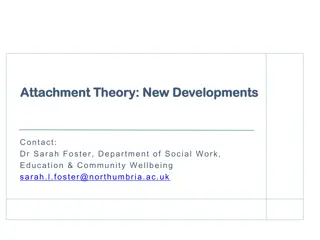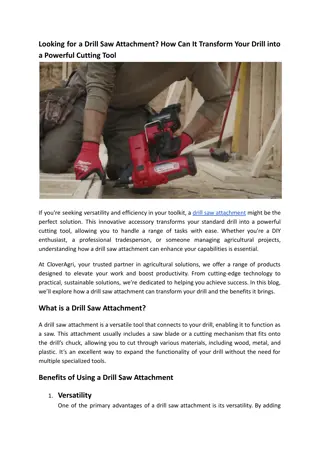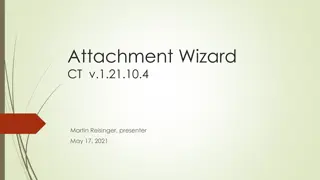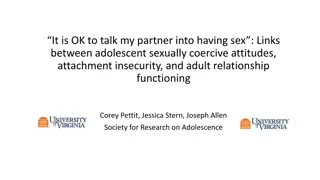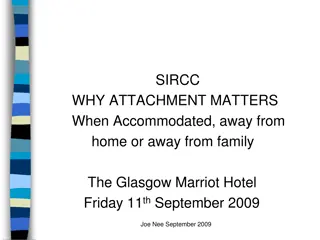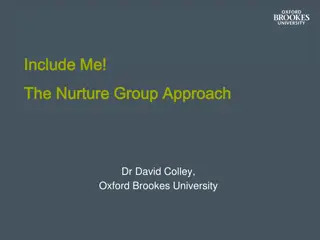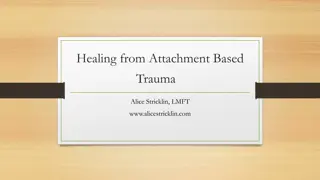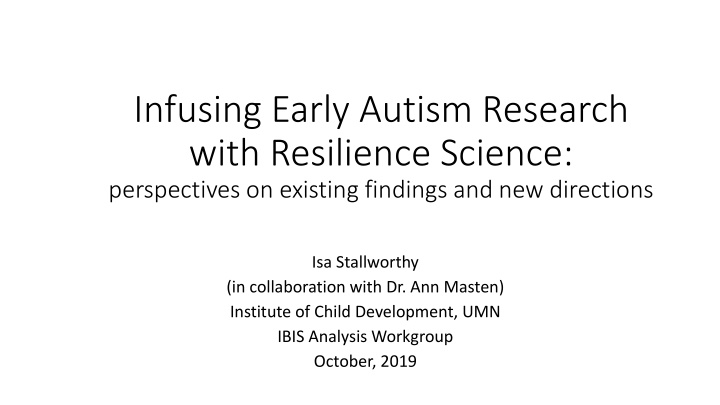
Perspectives on Infusing Early Autism Research with Resilience Science
Explore the intersection of autism research and resilience science, delving into the heterogeneity of autism Spectrum Disorder (ASD) and the potential for positive development pathways. This discussion highlights the importance of understanding both risk factors and protective mechanisms in ASD research, emphasizing a shift towards inclusive approaches that consider strengths and adaptive capacities alongside deficits.
Download Presentation

Please find below an Image/Link to download the presentation.
The content on the website is provided AS IS for your information and personal use only. It may not be sold, licensed, or shared on other websites without obtaining consent from the author. If you encounter any issues during the download, it is possible that the publisher has removed the file from their server.
You are allowed to download the files provided on this website for personal or commercial use, subject to the condition that they are used lawfully. All files are the property of their respective owners.
The content on the website is provided AS IS for your information and personal use only. It may not be sold, licensed, or shared on other websites without obtaining consent from the author.
E N D
Presentation Transcript
Infusing Early Autism Research with Resilience Science: perspectives on existing findings and new directions Isa Stallworthy (in collaboration with Dr. Ann Masten) Institute of Child Development, UMN IBIS Analysis Workgroup October, 2019
Setting the stage Core symptoms of ASD carry elevated risks to daily living and adaptive skills necessary for success Yet, so much heterogeneity in ASD: varying levels of core deficits, splinter skills, uneven profiles ASD [and consequences of ASD] implicate all facets of development at multiple levels of analysis Unsurprisingly, striking variation in Functioning within and around dx Outcomes over time Developmental pathways leading to and away from dx Most research focused on risk for ASD & related deficits
Setting the stage Deficit model has dominated research on the development of ASD much as it did in the history of developmental psychopathology for decades (Masten & Cicchetti, 2016) Very little focus on understanding positive patterns of development especially early in development Positive variation early in development Leading to and immediately following dx Mechanisms by and levels at which positive variation occurs Adaptive strengths later in development and adulthood
Aims Outline ways the HR infant siblings research model Has elucidated early pathways of risk for ASD Is an opportunity to study positive trajectories of ASD-related ability and disability Resilience frameworks in developmental psychopathology broaden the focus of theory and research questions; assessments; and interventions shift away from deficit-focused models to include positive influences in etiology Assessments of strengths & adaptive capacity in the bio-psycho-social systems that support and protect individual development Resilience science has much to offer infant siblings research A developmental systems approach to ASD research Inform understandings of ASD risk and etiology Provide a framework for studying protective factors and their mechanisms Pathways and mechanisms by which HR infants do not develop ASD Models of causality and intervention include assets or promotive factors and processes along with risks protective systems and processes along with liabilities or vulnerabilities.
What we know about risk for ASD 1 in 59 in general pop (Baio, 2018) Occurs in all ethnic, racial, and SES groups ~ 4 x more common in males (CDC) Familial risk 2-18 % of those w/ older sib (Ozonoff et al., 2011; Sumi et al., 2006) individual risk of ASD increases with increasing genetic relatedness (Sandin et al., 2014) MZ twin concordance ~96-99 % (DZ twin ~44-66; Tick et al., 2015) HR infant siblings research design (e.g., Baby Sibs Research Consortium; BSRC) HR v LR HR-NA v HR-AD v LR HR-NA v HR-AD v LR v LD/ DS
What have we learned and where are we going with infant siblings research?
Review: heterogeneity in pathways and outcome Lack of overt behavioral markers prior to 12 months (mentioned by all) Variety of course and timing of the onset of the behavioral phenotype (Rogers, 2009; Szatmari et al., 2016; Elsabbagh & Johnson, 2010) Even in infancy, each of the core symptoms, and developmental rate, may be severely or much more mildly affected(Rogers, 2009; Szatmari et al., 2016) autism involves symptoms across multiple domains with a gradual onset that changes both ongoing developmental rate and established behavioral patterns across the first 2 3 years of life (Rogers, 2009) Many pathways to ASD (Elsabbagh & Johnson, 2010) significant variation in the rate of change over time delays/atypicality can begin later and appear more gradually, leading to a plateau Possible alternative routes to autism that are segregated all the way through from the genetic to the clinical phenotype level (Gliga et al., 2014) Must identify not only markers for an ASD diagnosis, but for also predictors of the significant heterogeneity in developmental skills in both short and long-term developmental course (Jones et al., 2014) Multiplicative models account for the dynamic nature of functional brain development --a few initial factors interact and amplify (or decrease) each other s effects during development (Gliga et al., 2014)
Review: considering ASD risk Phenotypic variability is a result of a combination of multiple genetic factors, none of which is necessary or sufficient for autism emergence (Plomin et al., 2009; Gliga et al., 2014) It is only in a subset of [these] infants that initially subtle differences become compounded, leading into a developmental trajectory that results in an ASD outcome. In the majority of infants, however, well-described processes of brain adaptation and plasticity (discussed next) may restore the developmental trajectory to a typical course. (Elssabagh & Johnson, 2010) Symptoms of ASD likely emerge from a complex interaction between pre- existing vulnerabilities and the child's environment (Jones et al., 2014) In some cases, an early perturbation can reset a developmental trajectory along a different route, as a result of the compounding of atypical brain computations or behaviour eliciting or recruiting an atypical environment. (Elssabagh & Johnson, 2010) Importance of comparing different models of risk accumulation (e.g., Bedford et al., 2014): gaze following and disengagement of attention independently and additively predict clinical outcome (Gliga et al., 2014)
Review: considering protection Compensatory skills and pre-existing protective factors likely to play a role in the dynamics of a clinical phenotype (Jones et al., 2014) Examining developmental relationships is key to distinguishing risk markers, protective factors, and incidental findings. (Jones et al., 2014) In [some] cases, the typical developmental trajectory can be resilient in the face of genetic or early environmental hits through canalisation, a process through which brain adaptation and plasticity maintains or restores the typical trajectory. (Elssabagh & Johnson, 2010) Some factors may protect against specific risks (e.g., good language skills in girls diminishing the impact of atypical social interaction) whilst others may have wider impact (e.g., EF; Gliga et al., 2014) More research needed on the course of HR-non-ASD (Rogers, 2009) to understand variability (Szatmari et al., 2016) Does the apparent plasticity in the non ASD high risk sibs speak to the level of plasticity in infants who develop ASD? (Rogers, 2009)
[more] Considering protection Predictive power might also be increased if protective factors, intrinsic or environmental, are taken into account. (Gliga et al., 2014) Such protective factors could manifest as predictors of typical outcomes in high-risk populations. Although autism severity is remarkably stable over the course of life in a group-statistical sense, slow, steady recoveries occur in isolated cases, steady improvement in adaptive functioning is achievable for most patients, and hope is a crucial ingredient that allows families to continuously (throughout life) marshal the resources and support necessary to optimise the adaptation and development of affected individuals. (Constantino & Charman, 2016)
Resilience framework Contemporary systems definition of resilience The potential or manifested capacity of a dynamic system (e.g., an individual, a family, a community) to adapt successfully through multiple processes to challenges that threaten the function, survival, or positive development of the system (Masten, 2014, 2018; Masten & Cicchetti, 2016) Resilience capacity of a person Is dynamic and continually changing Due to the ongoing interactions that shape human development from cellular to social levels over time Varies across development and context Is therefore not a singular trait although traits may contribute to resilience Depends on many interdependent, interacting systems Involves multiple levels of interaction Can be studied at multiple levels of analysis
Resilience framework contd Must be considered in the context of risk, threat, or disturbance Resilience explicitly refers to the capacity available or already deployed to adapt effectively to challenges, threats, or stress Includes compensatory or promotive influences (positive influences observed regardless of risk level; main effects) as well as protective influences (greater positive influences when risk is high; buffers and moderators of adversity) Note that the same factor (e.g., good parenting, verbal skills) can work both ways some buffers are activated by adversity akin to the response of the immune system to an infection (parents can up their game in the face of a threat to their child) Who is doing well despite exposure to risk or adversity?
Parallels in widely reported resilience factors (Masten, 2018) Individual Resilience Research Family Systems Resilience Nurturing, sensitive caregiving Nurturing care of vulnerable members Attachment, security, belonging Family cohesion, sense of belonging Skilled parent management, discipline Maintaining family boundaries, rules Agency, motivation to adapt Active coping, mastery Problem-solving, planning Collaborative problems solving Self-regulation, emotion regulation Co-regulation, family balance Hope, faith, optimism Hope, faith, optimism Meaning making, life has meaning Coherence, family meaning making Positive views of the self or identity Positive views of family/family identity Routines and rituals Family routines and rituals
Existing work integrating resilience- related ideas into ASD research
Resilience factors of caregivers and family of those with ASD Evidence of resilience in families of children with ASD (Bayat, 2007) family connectedness and closeness, positive meaning making of the disability, and spiritual and personal growth Buffering effect of resilience on stress, anxiety, and depression in parent of children with ASD (Bitsika et al., 2013) Role of positive cognition for parents of children with ASD (Bekhet et al., 2012) Impact of social support on ASD family resilience (Plumb, 2011)
Investigating optimal outcomes following ASD dx Somewhere between 1.5-25% could lose ASD dx (Rutter, 1970; Helt et al., 2008) Optimal outcome = recovering from ASD (Lovaas, 1978) optimal outcome (OO) requires losing all symptoms of ASD in addition to the diagnosis, and functioning within the non-autistic range of social interaction and communication (Fein et al., 2013) OO group do not differ from TD on socialization, communication, face recognition, most language (Fein et al., 2013) No differences were found in symptom severity, socialization, or communication between children who lost the ASD diagnosis and children who did not (Sutera et al., 2007) OO predicted by fewer repetitive behaviors, less severe symptomatology and stronger adaptive skills early in life (Moulton et al., 2016)
Compensation during ASD life course Can older children with ASD compensate for deficits? (Kasari et al., 2001) Intact declarative memory may help scaffold social behavior (Ullman & Pullman, 2015) Compensation in neurodevelopmental disorders: how to explain improvement in outcomes? (Livingston & Happe, 2017) Compensation: good outcome despite persistence in underlying core cognitive deficits Shallow v deep, modulated by environment (e.g., niche construction), may come at a cost In adolescence, high compensators (good ADOS despite poor ToM) better IQ and EF but more anxiety compared to low compensators (Livingston et al., 2018) McPartland, 2019 critique and reflection re: Livingston & Happe, 2017 -- autism s existential crisis Only includes high functioning, mostly male, loose ASD criteria intrinsic features of ASD in an individual are unknowable through behav obs alone poses questions re: the validity of the diagnostic construct w/ important clinical implications While some symptoms may reflect vulnerabilities related to genetic or environmental risk factors, others will be manifestations of compensatory processes or secondary cascading effects following atypical interactions with the environment (Dennis et al., 2013; Johnson, Jones, & Gliga, 2015; Johnson et al., 2014) ID protective factors unique and common to ASD and ADHD
Neural models of adaptation and compensation EF may allow the brain to compensate via the PFC (Johnson, 2012) within those at-risk, those w/ strong EF skills are better able to compensate for atypicalities in other brain systems, and are therefore less likely to receive a dx Ontogenetic adaptation (Johnson, Jones, & Gliga, 2015) whole-brain processes that may protect or buffer individual development in the face of subtle widespread impairments in neural processing that would otherwise threaten typical ontogenetic adaptation. Resilience: ability of an organism to withstand dev challenges Ontogenetic adaptation does not necessarily result in typical/advantageous phenotype Redundancy, reorganization, niche construction, timing of developmental trajectories Autism is not a disorder of neurodevelopment, but rather as an adaptive common variant pathway of human functional brain development (Johnson, 2017)
Setting the stage for developmental resilience framework in early ASD research
Risk & resilience opportunities Resilience factors and competencies for older children and adolescents with ASD and applications in intervention (McCrimmon & Montgomery, 2014) re-framing of symptoms to a view of how they can be adapted and utilized as strengths to support developmental outcomes Moving away from a deficits approach to individual capacities of those w/ ASD Autism research should embrace resilience principles (Lai & Szatmarti, 2019) Editorial: prospects for considering ASD variability from resilience lens challenges in daily living that autistic people experience = risk experiences Risk and resilience in autism spectrum disorder: a missed translational opportunity? (Szatmari, 2018) exciting translational opportunities can be achieved through a greater focus on understanding protective factors and resiliency in ASD A focus on strengthening protective factors may improve long-term outcome.
How can a resilience framework enrich early ASD research? Applying a developmental resilience lens to existing HR infant siblings program of research: Offers new perspectives on current findings of early ASD risk & protection who is doing well (markers of resilience), how (domains, multiple levels of analysis), and when (timing of markers), to what ends (positive adaptive outcomes) Enrich our understanding of the development and amelioration of ASD-related disability early in life through new Re-thinking current research puzzles Research questions Analytic strategies Intervention approaches
Clarifications: risk as probabilistic ASD not necessarily an adversity/negative outcome in and of itself Many individuals with ASD lead independent and fulfilling lives In part because they were able to achieve key outcomes (i.e., language, IQ, adaptive function) despite their dx (resilience) Basis for terms like high-functioning and now outdated Asperger s syndrome Yet carrying an ASD dx increases likelihood of debilitating deficits ASD can pose a threat to life course development, adaptation, functioning Many cannot speak, live independently, IQ <70, have severe behaviors problems, etc. Moreover, core symptoms of ASD undermine the very key foundations for life course resilience in the face of hardship (i.e., social relationships, community connectedness) Importance of understanding early predictors of and pathways to positive outcome
Operational definitions: ASD risk risk Risk for developing ASD dx probabilistic, multiple levels, interactive What factors are associated with increased likelihood of developing ASD & related disability early in life? Main contexts of risk Familial risk (i.e., older sibling) Being male Risk markers early in life Fixed: genetic, chromosomal (i.e., sex) Variable: behavioral, neurological, physiological, clinical Predict ASD dx and level of impairment Better understanding of risk through knowing what mitigates it
Operational definitions: adaptive criteria positive outcomes adaptive criteria/key How do we know someone is doing well in the first 3 years of life? What are key criteria for positive adaptation Negative: avoiding ASD symptoms not meeting clinical criteria for an ASD dx (e.g., CBE) evading core impairments (BAP?) Positive: achieving normative levels of salient developmental competencies Composites of autistic traits (e.g., ADOS) Social communication (e.g., SRS) Adaptive daily living skills (e.g., VABS) Language abilities (e.g., MSEL) Executive functioning (e.g., MEFS)
Operational definitions: markers of positive outcomes outcomes markers of positive What markers early in development are associated with future positive outcomes? Can be promotive (i.e., are important regardless of risk for ASD) or protective (i.e., especially important in the context of ASD risk) (Masten & Cicchetti, 2016) Can change the predictive relationship btw risk factors and ASD (interaction) or by reducing levels of risk factors (main effect) Markers associated with positive ASD outcomes early in life Being female Exhibiting typical levels of early non-verbal communication, social engagement, language, adaptive function, brain dev over first 2 years Surveillance? (Micheletti et al., 2019)
What are the specific mechanisms by which factors protect from ASD-related disability? Processes involved in risk and protection may differ distinction also important for understanding respective mechanisms (Rutter, 1987) Moderators of risk that predict variation in adaptive function are indicators of either (or both), relative to norm: (Masten & Cicchetti, 2016) protection from typical risk vulnerability or added susceptibility Developmental cascades -- progressive or spreading changes across systems and time resulting from multiple-level interactions in complex living systems, that have cumulative effects on the course of a system s development (Masten & Cicchetti, 2010). Instantiating positive cascades competence begets competence Interrupting negative cascades
Who might be protected from developing ASD-related disability? Most people in the general population do not develop ASD Females Many HR infant siblings Some of those who receive a dx
Female protective effect (FPE) Females less likely to develop ASD (Ritvo et al., 1989; Constantino et al., 2010; Messinger et al., 2015) Increasing evidence of lack of sex differences in risk Females do not carry more liability (no denser familial loading) (Goin-Kochel et al., 2007) Recurrence rates equivalent for male and female probands (Constantino, 2014) Majority of heritable influence traced to autosomes (not sex chromosomes) (Constantino, 2017) Girls may have categorical protective advantage despite increased genetic risk (e.g., de novo mutations associated w/ some ASD) (Constantino, 2011) SHANK1 deletion associated with ASD for males only (Sato et al., 2012) Girls are less likely to be diagnosed unless symptoms are compounded by cog and other behavioral deficits (Dworzynski et al., 2012) In absence of those deficits, girls are better able to adapt to ASD liability (Constantino & Charman, 2012) Possibility of male-normed ASD assessments, female camouflage of symptoms
Resilience-based research avenues re: FPE Evidence for female protection against ASD? Throughout pop, females distribution of autistic traits are more non-pathologic (Constantino & Charman, 2012; Hull et al., 2016) Across all risk and outcome groups, girls performed better than boys on all dimensions of cog function and lower repetitive behaviors (Messinger et al., 2015) Females may have same level of risk factors but additional protective factors that ameliorate risk effects (e.g., Bedford et al., 2016) Evidence for male vulnerability additional risk? Developmental dimorphisms may move males closer to neurodevelopmental vulnerability thresholds (McCarthy & Wright, 2016) Males 4-8x more likely to have a neurodevelopmental disorder (Brothwood et al., 1986; Bale, 2016) it is also possible that rather than enhanced RF acting as a protective factor, low RF is acting as an additional risk factor, compounding the effects of other early markers of atypicality (Bedford et al., 2019) Disentangling Carter effect vs FPE more broadly (Messinger et al., 2015 v Constantino, 2016 v Messinger et al., 2016) Carter effect females with ASD carry greater genetic liability/risk FPE --sex-specific modulation of inherited liability What are the mechanisms by which females may overcome ASD risk? Young girls have been found to meet developmental milestones earlier than boys e.g., (Eriksson et al., 2012; Messinger et al., 2015; Zwaigenbaum et al., 2012). Early acquisition of skills --> positive cascade?
Predicting positive outcomes in infant siblings Predictors of positive outcome regardless of risk group General promotive factors Certain patterns of visual scanning predict higher expressive language scores regardless of risk (Elsabbagh et al., 2013) infants who fixated more on their mother s mouth during the 6- month interaction developed language at significantly higher rates and had significantly higher expressive language scores at 24 months (Young et al., 2009)
Predicting positive outcomes in infant siblings Characteristics that differentiate HR-NA infants from HR-ASD infants Possible promotive/protective factors? Levels of engagement, requesting, imitation, showing, gesture, intonation, fussiness at 12 mo (Macari et al., 2012) Language and communication at 12 & 18 mo (Mitchell et al., 2006; Landa & Garrett-Mayer, 2006) Extra-axial CSF at 6 mo (Shen et al., 2017) P400 amplitude for gaze shifts away versus toward at 6-10 mo (Elsabbagh et al., 2012) Faster growth in IJA from 8-18 mo (Ibanez et al., 2013) RJA cue-reading abilities in the first year of life (Stallworthy et al., in prep)
Predicting positive outcomes in infant siblings HR-NA infants often distinct from LR infants Do these matter for key criteria of adaptive function? Higher mean ADOS severity and lower verbal and non-verbal DQ than LR infants at 3 years (Messinger et al., 2013; Georgiades et al., 2013) Reduced surgency & effortful control in first 2 years (Clifford et al., 2013) Fewer play-related gestures at 18 mo (Mitchell et al., 2006) HR-NA infants seek interaction (social or non-social) less than their HR-ASD peers and LR infants (Clifford et al., 2013). Decreased seeking might protect a brain that is struggling to process an excess of stimulation (Gliga et al., 2014)
What protective factors exert main effects on/ interact with early risk markers? Regulatory function as a protective factor (Bedford et al., 2019) AOSI scores significantly predict ASD at 14 months only for those w/ low IBQ regulator function scores Maybe masking (i.e., shallow compensation) Sex differences in association btw several risk markers and later autistic traits (Bedford et al., 2016) AOSI total score, atten diseng speed, gaze following at 14 mo predict ADOS scores for boys only No sex differences found in any risk markers Language did not explain interaction Enhanced social attention in female HR siblings from 6-12 mo (Chawarska et al., 2016) Compared to HR males and LR male and females No dx outcomes
What do successful early interventions tell us about protective processes? What are the goals of successful early interventions? Targets: Child: positive affect, shared engagement, v/nv comm (Dawson et al., 2010), joint attention, symbolic play (Kasari et al., 2008; Schertz & Odom, 2007), interpersonal synchrony (Landa et al., 2010; Green et al., 2013), communication (Green et al., 2010; Carter et al., 2011; Drew et al., 2002; Steiner et al., 2013; Wetherby & Woods, 2006), social reciprocity, affective engagement (Estes et al., 2015), social motivation (Koegel et al., 2013; Steiner et al., 2013), attention/motivation (Rogers et al., 2012) Parent: responsivity/sensitivity (Dawson et al., 2010; Green et al., 2010; Green et al., 2013), communication (Drew et al., 2002) Outcomes: Child: ADOS scores (most common); IQ, adaptive behav, ASD dx (Dawson et al., 2010), language (Kasari et al., 2008), RJA (Kasari et al., 2010), imitation (Landa et al., 2010), child initiations, shared attention (Green et al., 2010), nonverbal cog skills (Dawson et al., 2010), language (Drew et al., 2002), liveliness (Green et al., 2013); social engagement (Koegel et al., 2013), communication (Steiner et al., 2013; Wetherby & Woods, 2006) Parent: responsivity (Carter et al., 2011), stress (Drew et al., 2002)
What do successful early interventions tell us about protective processes? How do successful interventions work? What systems do they involve? Alleviate core deficiencies and/ or strengthen compensatory processes? Cascades or incremental progress?
Trajectory approaches can elucidate patterns of deficits and protective factors Can these approaches identify key developmental cascades? Learning algorithm: 4 trajectories from ADOS T scores (Macari et al., 2012) indices of positive outcome: communicative behaviors (e.g., IJA), ability to regulate activity level and attention ASD outcomes predicted via subgroups of complex competencies and deficits Data mining: 3 subclasses of symptom severity (Chawarska et al., 2014) 3 combos at 18 months predict ASD: (1) poor eye contact + lack of communicative gestures and giving; (2) poor eye contact + lack of imaginative play; (3) and lack of giving + repetitive behaviors + intact eye contact. 4 classes of change in ADOS from 14-36 months (Kim et al., 2018) (1) increasing ASD symptoms + improvements in language/comm skills and adaptive abilities over time; (2) increases in RRB s + stability/improvements in social affect domain (e.g., language & RJA); (3) improvement in some social affect trajectories + stability of RRB s Challenge of applying these findings to clinical practice (Charman, 2018)
How do risk [and protective] makers interact with each other over time? Additive effects of social and non-social attention during infancy relate to later ASD (Bedford et al., 2012) Classification tree analysis examines interactions between variables and automatically performs variable selection (Macari et al., 2012)
When do protective/promotive factors influence development? Known sensitive periods early in development Importance of densely sampled prospective longitudinal studies examine how combinations of protective factors emerge over time to predict positive outcomes Do early language skills and social experience set in motion positive cascades (i.e., exponential increases in other abilities?) In relation to what risk markers? Assessing aspects of chronogeneity --Individualized pathways over time (Georgiades et al., 2017) What are the turning points? Mixed membership frameworks --individuals are allowed multiple membership on a set of profiles characterized by time dependent trajectories Cross-lagged relationships btw domains over time Many of the same ideas for assessing heterogeneity of risk (e.g., Lombardo et al., 2019)
Resilience-oriented prospective longitudinal research strategies Person- and variable- centered approaches to understanding which factors exert main effect or interact with risk factors to predict outcomes Multiple levels of analysis to study of protective/promotive factors Dense prospective longitudinal sampling throughout first 2 years of life Focus on risk for ASD-related disability outcomes for sub-threshold groups and those who meet dx criteria Brand new methods! interactive, time-varying processes that lead to positive outcomes via a dynamic network approach to risk and resilience (e.g., Kalisch et al., 2019)
Other key resilience-oriented early ASD research questions What is true evidence of resilience? True positive pathway v temporary masking compensation v imprecise measurement What is the significance of lack of overt behavioral markers in first 12 months? Protective processes for late dx at 36 months? (Ozonoff et al., 2015)? Is BAP (10-20% of HR-NA; Messinger et al., 2013)) a true signature of protective processes? Often assumed there was less risk to begin with (Livingston & Happe, 2017) BAP may index greater compensatory processes (Skuse, 2007) What are the core features/etiologies of ASD What are the core deficits vs consequences? What are core protective factors and their consequences early in life? Do core risk and protective factors operate in simplex families/gen pop? Are they ASD-specific?
More key resilience-oriented early ASD research questions What are key adaptive outcomes of interest? Incorporate perspectives from individuals on the spectrum & families Best possible outcomes considering a child s history? (Georgiades & Kasari, 2018) Overlooked are the many individuals with autism who are able to communicate despite their inability to use spoken language, or individuals with measurable intellectual disability but who function well in their chosen task or job. Rather than symptom abatement, broader orientation towards quality of life may be more appropriate as an outcome (McPartland, 2019) For some individuals, traditional therapies oriented towards improving language and prosocial behavior may remain optimal. In contrast, for others, non-social functional goals may be the best strategy for improving quality of life


